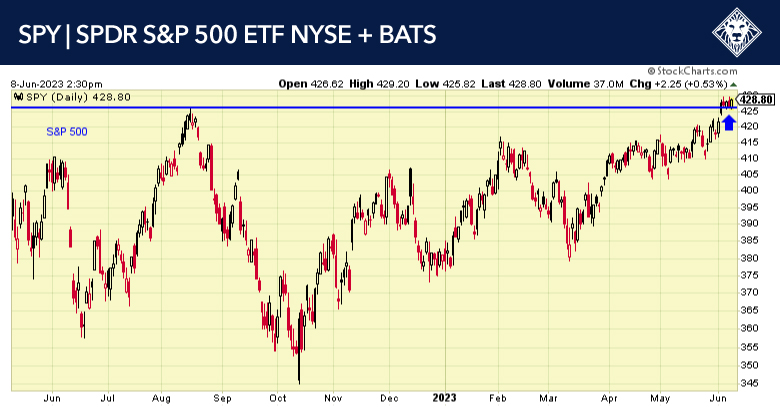Markets in a Bullish Landscape, but Beware of Speed Bumps

Chart: SPY 1-year daily
Last week we witnessed the market sell off hard on Thursday and rally back even stronger on the PCE news, which was very encouraging. The markets are clearly in an uptrend and look strong, but with that said, they are looking a bit frothy. A pullback is warranted and probably near-term, but it should be shallow and short-lived. There is a tremendous amount of cash on the sidelines, and investors are way underinvested, which should create a nice base to work higher from.

Chart: SOXX 1-year daily
The semiconductor index is still strong, with chips and AI being the leading areas of the rally. This indicates that the market is broadening out, which is one of the key ingredients in confirming a new bull market, which we believe we entered in late January.
Inflation pressures continued to moderate in June, confirming the Fed’s shift to a slower pace of tightening this year. Most of the slowdown in inflation, including in the latest month, has come from the goods side. But core inflation continues to run above the Fed’s target of 2.0%, as underlying price pressures, including from the super-core, remain elevated. As favorable base effects wane in the second half of this year, further progress on inflation will prove more difficult, especially if the labor market remains tight and consumer demand holds up. This suggests that while the Fed may be nearing the end of its tightening cycle, it may keep rates higher for longer than markets currently anticipate.
The PCE Price Index and its core both picked up 0.2% in June from the prior month, matching the consensus estimate. For the core, this was the smallest gain in nearly a year, led almost exclusively by lower goods prices. Indeed, core goods prices fell 0.1%, down for the first time this year, while core services prices rose a near-steady 0.3%. Within services, both housing and super-core prices (i.e., services ex-energy and housing) posted similar gains to the prior month.
The Employment Cost Index (ECI) rose 1.0% in Q2, the smallest gain in two years, and below the consensus estimate of 1.1%. Both private sector and government employee compensation eased slightly from the prior quarter. Within the private sector, there was a notable deceleration in goods-producing industries compensation costs, with wages and salaries rising only 0.6%. This was a significant drop-off from the 1.5% gain in the previous quarter, and it was the smallest gain since Q3 2020. Service sector wages and salaries, however, rose a steady 1.1%, the same for three consecutive quarters, and higher than the 0.7% average in the three years prior to the pandemic.
















